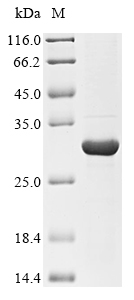Recombinant Hypoderma lineatum Hypodermin-B is produced in E. coli, covering the full length of the mature protein from amino acids 31 to 256. This protein includes an N-terminal 10xHis-tag and a C-terminal Myc-tag, allowing for efficient purification and detection. SDS-PAGE analysis shows the product demonstrates a purity greater than 85%, which appears to make it suitable for various research applications.
The early cattle grub, Hypoderma lineatum, produces an enzyme called Hypodermin-B. This protein plays what seems to be a crucial role in the parasite's life cycle, helping with tissue invasion and nutrient acquisition. Parasitology and veterinary researchers find this protein particularly interesting because it may help explain host-parasite interactions and the biological mechanisms that drive Hypoderma species infestations.
Potential Applications
Note: The applications listed below are based on what we know about this protein's biological functions, published research, and experience from experts in the field. However, we haven't fully tested all of these applications ourselves yet. We'd recommend running some preliminary tests first to make sure they work for your specific research goals.
1. Antibody Development and Immunological Studies
This recombinant Hypodermin-B serves as an excellent immunogen for generating antibodies against linear epitopes of the protein. The full-length mature sequence ensures comprehensive epitope coverage. The dual tags facilitate purification and screening. However, antibodies may not efficiently recognize conformational epitopes on the native, properly folded enzyme.
2. Biochemical Characterization
This is the essential first step to assess physical properties. Techniques like circular dichroism can analyze secondary structure, while thermal shift assays evaluate stability. These studies are critical to reveal the properties of the protein itself, not the native protein.
3. ELISA-Based Detection System Development
This protein is well-suited as a standard for quantitative ELISA to detect anti-Hypodermin-B antibodies. The assay depends on antibody binding to linear epitopes, so the protein's folding state is less critical. The tags enable consistent immobilization for reliable standard curves.
Final Recommendation & Action Plan
This recombinant Hypodermin-B is primarily suitable for antibody development and immunoassay applications but fundamentally unsuitable for functional studies due to E. coli's inability to produce properly folded enzyme. The immediate priority is Application 2 (Biochemical Characterization) to assess the protein's physical properties. Applications 1 and 3 (Antibody Development and ELISA) can proceed confidently. Interaction studies must be avoided due to the high probability of misfolding. For functional protease studies, alternative approaches using eukaryotic expression systems or native purification from the parasite are essential.






